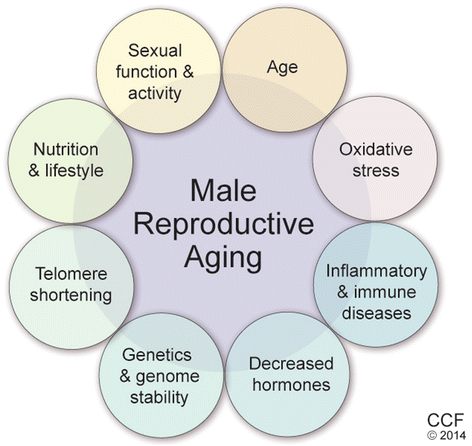Effects of increased paternal age on sperm quality, reproductive outcome and associated epigenetic risks to offspring
- PMID: 25928123
- PMCID: PMC4455614
- DOI: 10.1186/s12958-015-0028-x
Effects of increased paternal age on sperm quality, reproductive outcome and associated epigenetic risks to offspring
Abstract
Over the last decade, there has been a significant increase in average paternal age when the first child is conceived, either due to increased life expectancy, widespread use of contraception, late marriages and other factors. While the effect of maternal ageing on fertilization and reproduction is well known and several studies have shown that women over 35 years have a higher risk of infertility, pregnancy complications, spontaneous abortion, congenital anomalies, and perinatal complications. The effect of paternal age on semen quality and reproductive function is controversial for several reasons. First, there is no universal definition for advanced paternal ageing. Secondly, the literature is full of studies with conflicting results, especially for the most common parameters tested. Advancing paternal age also has been associated with increased risk of genetic disease. Our exhaustive literature review has demonstrated negative effects on sperm quality and testicular functions with increasing paternal age. Epigenetics changes, DNA mutations along with chromosomal aneuploidies have been associated with increasing paternal age. In addition to increased risk of male infertility, paternal age has also been demonstrated to impact reproductive and fertility outcomes including a decrease in IVF/ICSI success rate and increasing rate of preterm birth. Increasing paternal age has shown to increase the incidence of different types of disorders like autism, schizophrenia, bipolar disorders, and childhood leukemia in the progeny. It is thereby essential to educate the infertile couples on the disturbing links between increased paternal age and rising disorders in their offspring, to better counsel them during their reproductive years.
Figures
Similar articles
-
Impact of Advanced Paternal Age on Fertility and Risks of Genetic Disorders in Offspring.Genes (Basel). 2023 Feb 14;14(2):486. doi: 10.3390/genes14020486. Genes (Basel). 2023. PMID: 36833413 Free PMC article. Review.
-
Pregnancy outcomes after assisted human reproduction.J Obstet Gynaecol Can. 2014 Jan;36(1):64-83. doi: 10.1016/S1701-2163(15)30685-X. J Obstet Gynaecol Can. 2014. PMID: 24444289
-
Paternal age over 50 years decreases assisted reproductive technology (ART) success: A single UK center retrospective analysis.Acta Obstet Gynecol Scand. 2021 Oct;100(10):1858-1867. doi: 10.1111/aogs.14221. Epub 2021 Aug 17. Acta Obstet Gynecol Scand. 2021. PMID: 34405396
-
Paternal age and assisted reproductive outcomes in ICSI donor oocytes: is there an effect of older fathers?Hum Reprod. 2014 Oct 10;29(10):2114-22. doi: 10.1093/humrep/deu189. Epub 2014 Jul 28. Hum Reprod. 2014. PMID: 25073975 Free PMC article.
-
Reproductive genetics and the aging male.J Assist Reprod Genet. 2018 Jun;35(6):933-941. doi: 10.1007/s10815-018-1148-y. Epub 2018 Mar 9. J Assist Reprod Genet. 2018. PMID: 29524155 Free PMC article. Review.
Cited by
-
Environmental and Genetic Traffic in the Journey from Sperm to Offspring.Biomolecules. 2023 Dec 7;13(12):1759. doi: 10.3390/biom13121759. Biomolecules. 2023. PMID: 38136630 Free PMC article. Review.
-
The Correlation of Paternal Age on Semen Parameters in Assisted Reproduction: A Retrospective Study in Qassim, Saudi Arabia.Cureus. 2024 Jun 4;16(6):e61632. doi: 10.7759/cureus.61632. eCollection 2024 Jun. Cureus. 2024. PMID: 38966445 Free PMC article.
-
What Does Intracytoplasmic Sperm Injection Change in Embryonic Development? The Spermatozoon Contribution.J Clin Med. 2023 Jan 14;12(2):671. doi: 10.3390/jcm12020671. J Clin Med. 2023. PMID: 36675600 Free PMC article. Review.
-
The use of fluorescence in situ hybridization analysis on sperm: indications to perform and assisted reproduction technology outcomes.J Assist Reprod Genet. 2019 Oct;36(10):1975-1987. doi: 10.1007/s10815-019-01554-2. Epub 2019 Aug 8. J Assist Reprod Genet. 2019. PMID: 31396849 Free PMC article.
-
Single-cell analysis of human testis aging and correlation with elevated body mass index.Dev Cell. 2022 May 9;57(9):1160-1176.e5. doi: 10.1016/j.devcel.2022.04.004. Epub 2022 May 2. Dev Cell. 2022. PMID: 35504286 Free PMC article.
References
-
- Handelsman DJ, Staraj S. Testicular size: the effects of aging, malnutrition, and illness. J Androl. 1985;6:144–51. - PubMed
-
- Feldman HA, Longcope C, Derby CA, Johannes CB, Araujo AB, Coviello AD, et al. Age trends in the level of serum testosterone and other hormones in middle-aged men: longitudinal results from the Massachusetts male aging study. J Clin Endocrinol Metab. 2002;87:589–98. - PubMed
-
- Agarwal A, Makker K, Sharma R. Clinical relevance of oxidative stress in male factor infertility: an update. Am J Reprod Immunol. 2008;59:2–11. - PubMed
Publication types
MeSH terms
LinkOut - more resources
Full Text Sources
Other Literature Sources
Medical


